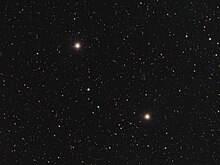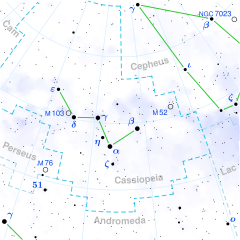Upsilon1 Cassiopeiae
| Observation data Epoch J2000.0 Equinox J2000.0 (ICRS) | |
|---|---|
| Constellation | Cassiopeia |
| Right ascension | 00h 55m 00.15523s[1] |
| Declination | +58° 58′ 21.7108″[1] |
| Apparent magnitude (V) | 4.82[2] |
| Characteristics | |
| Spectral type | K2 III[3] |
| U−B color index | +1.25[2] |
| B−V color index | +1.21[2] |
| Astrometry | |
| Radial velocity (Rv) | −23.57[4] km/s |
| Proper motion (μ) | RA: −33.50±0.36[1] mas/yr Dec.: −40.82±0.33[1] mas/yr |
| Parallax (π) | 9.93 ± 0.49 mas[1] |
| Distance | 330 ± 20 ly (101 ± 5 pc) |
| Absolute magnitude (MV) | −0.644[4] |
| Details | |
| Mass | 1.39[5] M☉ |
| Radius | 21[6] R☉ |
| Luminosity | 174[5] L☉ |
| Surface gravity (log g) | 1.76[4] cgs |
| Temperature | 4,422±14[5] K |
| Metallicity [Fe/H] | −0.25[4] dex |
| Rotational velocity (v sin i) | 1.1[7] km/s |
| Age | 4.75[5] Gyr |
| Other designations | |
| Database references | |
| SIMBAD | data |

Upsilon1 Cassiopeiae (υ1 Cassiopeiae) is an astrometric binary[9] star system in the northern constellation of Cassiopeia. It is visible to the naked eye with an apparent visual magnitude of 4.82.[2] Based upon an annual parallax shift of 9.93 mas as seen from Earth,[1] this system is located about 330 light years from the Sun.
The visible component is an evolved K-type giant star with a stellar classification of K2 III.[3] With an estimated age of 4.75 billion years,[5] it is a red clump star that is generating energy through the fusion of helium at its core.[10] The measured angular diameter, after correction for limb darkening, is 1.97±0.02 mas.[11] At the estimated distance of the star, this yields a physical size of about 21 times the radius of the Sun.[6] It has 1.39 times the mass of the Sun and is radiating 174 times the Sun's luminosity from its expanded photosphere at an effective temperature of 4,422 K.[5]
There is a magnitude 12.50 visual companion at an angular separation of 17.80 arc seconds along a position angle of 61°, as of 2003. A more distant magnitude 12.89 companion lies at a separation of 93.30 arc seconds along a position angle of 125°, as measured in 2003. Neither star appears to be physically associated with υ1 Cas.[12]
References
[edit]- ^ a b c d e f van Leeuwen, F. (2007), "Validation of the new Hipparcos reduction", Astronomy and Astrophysics, 474 (2): 653–664, arXiv:0708.1752, Bibcode:2007A&A...474..653V, doi:10.1051/0004-6361:20078357, S2CID 18759600.
- ^ a b c d Argue, A. N. (1966), "UBV photometry of 550 F, G and K type stars", Monthly Notices of the Royal Astronomical Society, 133 (4): 475, Bibcode:1966MNRAS.133..475A, doi:10.1093/mnras/133.4.475.
- ^ a b Eggen, O. J. (1962), "Space-velocity vectors for 3483 stars with proper motion and radial velocity", Royal Observatory Bulletin, 51: 79, Bibcode:1962RGOB...51...79E.
- ^ a b c d Soubiran, C.; et al. (2008), "Vertical distribution of Galactic disk stars. IV. AMR and AVR from clump giants", Astronomy and Astrophysics, 480 (1): 91–101, arXiv:0712.1370, Bibcode:2008A&A...480...91S, doi:10.1051/0004-6361:20078788, S2CID 16602121.
- ^ a b c d e f Luck, R. Earle (September 2015), "Abundances in the Local Region. I. G and K Giants", The Astronomical Journal, 150 (3): 23, arXiv:1507.01466, Bibcode:2015AJ....150...88L, doi:10.1088/0004-6256/150/3/88, S2CID 118505114, 88.
- ^ a b Lang, Kenneth R. (2006), Astrophysical formulae, Astronomy and astrophysics library, vol. 1 (3rd ed.), Birkhäuser, ISBN 3-540-29692-1. The radius (R*) is given by:
- ^ De Medeiros, J. R.; et al. (November 2000), "Rotation and lithium in single giant stars", Astronomy and Astrophysics, 363: 239–243, arXiv:astro-ph/0010273, Bibcode:2000A&A...363..239D.
- ^ "ups01 Cas". SIMBAD. Centre de données astronomiques de Strasbourg. Retrieved 2017-08-30.
- ^ Eggleton, P. P.; Tokovinin, A. A. (September 2008), "A catalogue of multiplicity among bright stellar systems", Monthly Notices of the Royal Astronomical Society, 389 (2): 869–879, arXiv:0806.2878, Bibcode:2008MNRAS.389..869E, doi:10.1111/j.1365-2966.2008.13596.x, S2CID 14878976.
- ^ Valentini, M.; Munari, U. (November 2010), "A spectroscopic survey of faint, high-Galactic-latitude red clump stars. I. The high resolution sample", Astronomy and Astrophysics, 522: A79, arXiv:1007.0207, Bibcode:2010A&A...522A..79V, doi:10.1051/0004-6361/201014870, S2CID 119156545.[permanent dead link]
- ^ Richichi, A.; et al. (February 2005), "CHARM2: An updated Catalog of High Angular Resolution Measurements", Astronomy and Astrophysics, 431 (2): 773–777, Bibcode:2005A&A...431..773R, doi:10.1051/0004-6361:20042039.
- ^ Mason, B. D.; et al. (2014), "The Washington Visual Double Star Catalog", The Astronomical Journal, 122 (6): 3466, Bibcode:2001AJ....122.3466M, doi:10.1086/323920.


